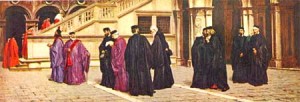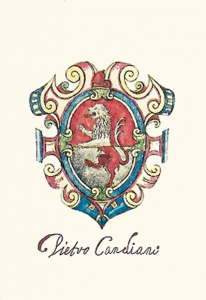Venice in the year one thousand
Just before the year one thousand, Venice was fighting with pirates from Neretva faithful to the Croats.
On year 933- submission of Istria, gradually transformed into inner territory of the republic and remain faithful until the fall of Venice.
-948 -The naval espedition headed by Peter III Candiano against Dalmatia, but there will never be a complete submission.
Especially the possession of the coast was of paramount importance to Venice , even to eradicate piracy .
-996 -Furious repression of Slavic pirates . Lissa ,an important Slave city is put to fire and sword .
In the year one thousand (according to the prophecies had to be to be the end of the world  ), on Ascension Day ,Venice came out in the sea with a fleet commanded by Doge Pietro II Orseolo .The Doge, after obtaining the approval of Byzantium, and had received the ” banner of St. Mark ” rafiguration of the winged lion , went to persuade obedience to the islands of Korcula and Hvar ;the ancient Roman city : Porec, Pula , Rab , Krk or Zana , Trogir , Spalato.They submitted the pirates from Neretva ( of Slavic origin name comes from the River Neretva ) and conquered the city of Dubrovnik , the expedition becomes a triumphal Crusade . ( To commemorate this expedition was also determined that each year , on Ascension Day , the Doge with the bishop and all the councilors were on a vessel in front of the Lido to celebrate a commemorative rite , would be born the well-known ceremony of marriage with the sea , or the “Feast of the Sensa “. )
), on Ascension Day ,Venice came out in the sea with a fleet commanded by Doge Pietro II Orseolo .The Doge, after obtaining the approval of Byzantium, and had received the ” banner of St. Mark ” rafiguration of the winged lion , went to persuade obedience to the islands of Korcula and Hvar ;the ancient Roman city : Porec, Pula , Rab , Krk or Zana , Trogir , Spalato.They submitted the pirates from Neretva ( of Slavic origin name comes from the River Neretva ) and conquered the city of Dubrovnik , the expedition becomes a triumphal Crusade . ( To commemorate this expedition was also determined that each year , on Ascension Day , the Doge with the bishop and all the councilors were on a vessel in front of the Lido to celebrate a commemorative rite , would be born the well-known ceremony of marriage with the sea , or the “Feast of the Sensa “. )
November 16,year 1000: Emperor Henry II confirmed the privileges and recognizes to the Venetian doge the title of “Duke of Venetics and Dalmatians” ( Dux Dalmatiae ) and for the first time it was proclaimed the ” domain of the gulf .” When the Emperor of the West became stepfather to the children of the Duke ,Venice conquest Bari and Taranto for the Byzantine Empire . At the same time the Papacy , fallen into Saracen hands .
One year after ” the theft” of the remains of St. Mark (828) from Constantinople began the construction of the basilica that bears his name.The facade of the basilica of San Marco looked different from the current one .
The first Basilica was destroyed along with the houses around ,by the fire applied by the enemies of the Doge Candiano . Was rebuilt by the Doge Orseolo the first, before leaving Venice and became monaco in Pyrenees mountains, where he lived for a long time , devoted to exercises of penance.
The fortified palace of the Doge is erected on an old Roman ruin ; many churches ( the oldest : San Moise ) and many houses were built in the same year.
Piazza San Marco was more narrow and crossed by the Rio Batario , and the church San Geminianus, ” which was moved in order to ampliate the square (the year 1500 by san Sovino ) then demolished by Napoleon to make way for the staircase and the ballroom of Eugene Beaumaris .The present square in front of the lagoon was almost all ocupated from a dock .
The island of San Giorgio Maggiore had already built a Benedictine abbey .
The tower and the bell tower was part of the defensive system created by the Doge Pietro Tribune after the attempted for conquest by the Hungarians in the year 899: a long wall that stretched from the castle of Olivolo up to another tower between St. Mosee and St. Mary Zogenigod from which started the chain that blocked the canal and was headed to another tower at St. Gregory .
On the banks of the canal (which changed its name from time to time : Santa Clara, San Marco, rio Zirada , rio Beculo , Rialto Channel ) the churches were already aligned among the houses built of wood, but also real palaces ( Foscari )
In St. Gregory isle was a large lake owned by the imperial Byzantine dignitary Domenico Morosini , and the fishpond called ” Badoer ”
The Venetian people goes for water and only water, almost all the buildings facing on rivers , and there are ” fifty thousand small boats or gondolas .The vegetable gardens are on the estuary islands in ( Lido) , the vineyards on the” Vignole “(vineyards) ,the horses to” Cavalino “(little horse) their vocation defining also their name.
The salt – precious Venetian monopoly – defended with weapons is produced close to the city ( in St. George near Giudeca ) then called ” Spina ” ( and succeeded the abolition duties on the import of salt) , with the channel called ” Vignano ” that separated it from the rest of the city . The “Arsenale” is not yet born (will be built in 1004 ) and the factories of oars and galley , the yards ” dry docks for ship” are everywere in different squares .
The market ( Rialto ) is located on the other side of the canal to San Bartolomio . On the island there were a current pool ” poncianica” and ” Bécarie ” the slaughterhouse , were the spoil of the Duke Peter Candiano IV and his family ( including his son ) were thrown .
The donation of the children of Stephen Orio will open the way to new market that we know today at the end of the century.
There are already a social organisation the ” old houses ” of ancestors Patrizi called “the process ” , and a crowd of free artisans ( free slaves also ) , already made in associations called ” fraglie ” .
The navigators and merchants give rise to the” new homes ” the future patrician elite.
From the year 1100 , Venice became a major Mediterranean power and offered their services as fleet of ship to the Bizantine Empire.Due to its former glory and to its economic prosperity , Venice became a military target area from several countries , including France, Spain and Turkey. Finally Venice separated from decadent Byzantine Empire in 1203 during the Fourth Crusade when the Venetians soldiers stormed and conquered Constantinople . From the east the Venetian soldiers brought the riches that can be seen in the church of San Marco : gold,precious marbles,sculptures, etc.
other items http://dipoco.altervista.org/
visit my website http://ginocosta.altervista.org/